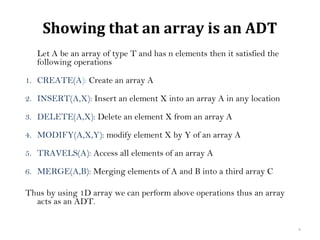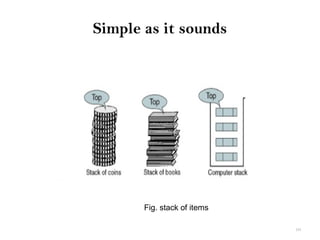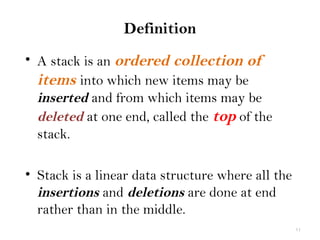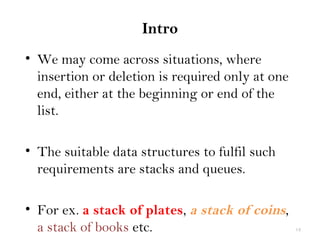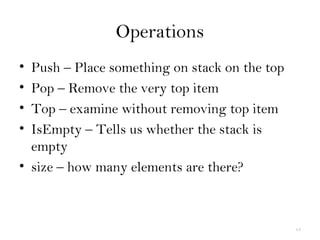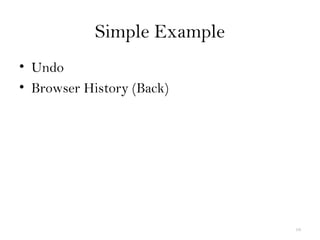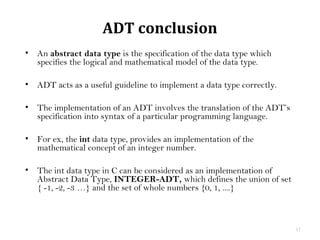Abstract data types (adt) intro to data structure part 2
- 2. 2
- 3. 3
- 4. 4
- 5. Abstract Data Types (ADT) ’é¦ We are well acquainted with data types by now, like integers, arrays, and so on. ’é¦ To access the data, we've used operations defined in the programming language for the data type, for instance by accessing array elements by using the square bracket notation. ’é¦ An abstract data type is a data type whose representation is hidden from, and of no concern to the application code. 5
- 6. Abstract Data Types (ADT) ’é¦ For example, when writing application code, we donŌĆÖt care how strings are represented: we just declare variables of type string, and manipulate them by using string operations. ’é¦ Once an abstract data type has been designed, the programmer responsible for implementing that type is concerned only with choosing a suitable data structure and coding up the methods. ’é¦ On the other hand, application programmers are concerned only with using that type and calling its methods without worrying much about how the type is implemented. 6
- 7. The Array As An ADT ŌĆó An array is probably the most versatile or fundamental Abstract Data Type ŌĆó An array is a finite sequence of storage cells, for which the following operations are defined: ŌĆō create(A,N)creates an array A with storage for N items; ŌĆō A[i]=item stores item in the ith position in the array A; and ŌĆō A[i] returns the value of the item stored in the ith position in the array A. 7
- 8. Showing that an array is an ADT Let A be an array of type T and has n elements then it satisfied the following operations 1. CREATE(A): Create an array A 2. INSERT(A,X): Insert an element X into an array A in any location 3. DELETE(A,X): Delete an element X from an array A 4. MODIFY(A,X,Y): modify element X by Y of an array A 5. TRAVELS(A): Access all elements of an array A 6. MERGE(A,B): Merging elements of A and B into a third array C Thus by using 1D array we can perform above operations thus an array acts as an ADT. 8
- 9. The STACK 9
- 10. Simple as it sounds Fig. stack of items 10
- 11. Definition ŌĆó A stack is an ordered collection of items into which new items may be inserted and from which items may be deleted at one end, called the top of the stack. ŌĆó Stack is a linear data structure where all the insertions and deletions are done at end rather than in the middle. 11
- 12. Intro ŌĆó We may come across situations, where insertion or deletion is required only at one end, either at the beginning or end of the list. ŌĆó The suitable data structures to fulfil such requirements are stacks and queues. ŌĆó For ex. a stack of plates, a stack of coins, a stack of books etc. 12
- 13. Stack as an abstract data type ŌĆó A stack of elements of type T is a finite sequence of elements together with the operations 1. CreateEmptyStack(S): create or make stack S be an empty stack 2. Push(S,x): Insert x at one end of the stack, called its top 3. Top(S): If stack S is not empty; then retrieve the element at its top 4. Pop(S): If stack S is not empty; then delete the element at its top 5. IsFull(S): Determine if S is full or not. Return true if S is full stack; return false otherwise 6. IsEmpty(S): Determine if S is empty or not. Return true if S is an empty stack; return false otherwise. 13
- 14. 14
- 15. Operations ŌĆó Push ŌĆō Place something on stack on the top ŌĆó Pop ŌĆō Remove the very top item ŌĆó Top ŌĆō examine without removing top item ŌĆó IsEmpty ŌĆō Tells us whether the stack is empty ŌĆó size ŌĆō how many elements are there? 15
- 16. Simple Example ŌĆó Undo ŌĆó Browser History (Back) 16
- 17. ADT conclusion ŌĆó An abstract data type is the specification of the data type which specifies the logical and mathematical model of the data type. ŌĆó ADT acts as a useful guideline to implement a data type correctly. ŌĆó The implementation of an ADT involves the translation of the ADTŌĆÖs specification into syntax of a particular programming language. ŌĆó For ex, the int data type, provides an implementation of the mathematical concept of an integer number. ŌĆó The int data type in C can be considered as an implementation of Abstract Data Type, INTEGER-ADT, which defines the union of set { -1, -2, -3 ŌĆ”} and the set of whole numbers {0, 1, ....} 17


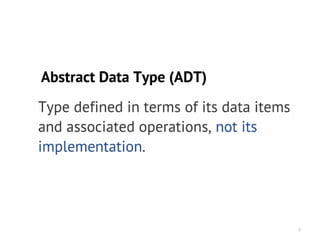




![The Array As An ADT
ŌĆó An array is probably the most versatile or
fundamental Abstract Data Type
ŌĆó An array is a finite sequence of storage cells,
for which the following operations are defined:
ŌĆō create(A,N)creates an array A with storage for N
items;
ŌĆō A[i]=item stores item in the ith
position in the array
A; and
ŌĆō A[i] returns the value of the item stored in the ith
position in the array A.
7](https://image.slidesharecdn.com/abstractdatatypesadt-introtodatastructurepart2-170724201316/85/Abstract-data-types-adt-intro-to-data-structure-part-2-7-320.jpg)
